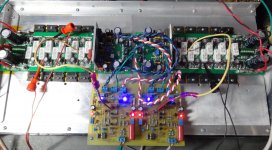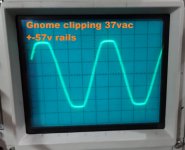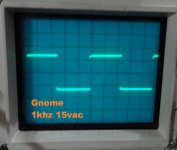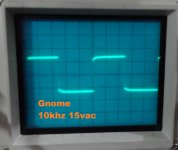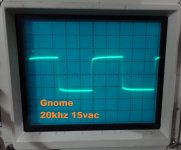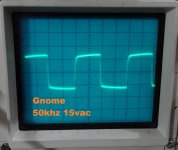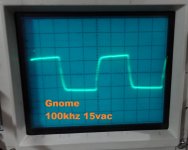they glue the bottom side smt parts to hold them on for soldering op such as a wave solder machine. if it is fine pitch smt both sides they play with the solder alloys to have different re-flow temps.Originally Posted by Kindhornman View Post
JW,
So I assume then that when they do two layer smd boards they use fixtures to hold the components in place on the bottom layer while they are baking both the top and bottom layers?
Last edited:
If the main rail decoupling caps are going right to the star ground, is there any use in even connecting the input ground to the output board at all? Would it be better to run it straight to the main star ground in the amplifier an bypass the extra connections?
they glue the bottom side smt parts to hold them on for soldering op.
I never thought of that! They would need to align the parts better than I do by hand then. I might try this with some larger devices on the bottom to save hand soldering.
the correct way to do it.If the main rail decoupling caps are going right to the star ground,
i think so, run signal grounds to common point as well as zobel filters.is there any use in even connecting the input ground to the output board at all? Would it be better to run it straight to the main star ground in the amplifier an bypass the extra connections?
OS,
If you were to build a Slewmaster with the Krypton-C or ND and you only needed 30 watts output, what single pair of output devices would you use? I'm thinking about the tweeter amp and how do you limit the output of the amp but still use the topology?
You could use the same OPS for a 30W or 60W amp , just limit the cap multiplier's voltage output and scale the input amplitudes accordingly.
A pair of MJL's or even latFET's will do here.
The topology not only soft clips , but the cascode leds can be used to detect
this clipping (dual led opto's instead for the ND !)
Add the bass amp , 3 -24 db/ octave filters ,and have a 3 way with individual
amps. Repaired a top of the line JBL THX 2.1 (owned it too). That had
LM3886 amps for each of the 2 way satellites and bridged 3886's for the sub -
6 amps total. You could adjust the gain of 5 amps in that tri-amped system.
OS
rsavas,
Thanks for that, it makes perfect sense. Do you happen to know what type of adhesive they use? I suspect a CA or UV set acrylic but just guessing what I would use.
Thanks for that, it makes perfect sense. Do you happen to know what type of adhesive they use? I suspect a CA or UV set acrylic but just guessing what I would use.
If the main rail decoupling caps are going right to the star ground, is there any use in even connecting the input ground to the output board at all? Would it be better to run it straight to the main star ground in the amplifier an bypass the extra connections?
The IPS rail decoupling caps are only "cleaning up" after the cap multiplier.
What they return to ground is quite minor.
They should be called the "post-multiplier" decoupling caps. G2 on the IPS/and
OPS (multipliers), is a really clean ground compared to the main OPS ground
(G1).
The whole of G2 could be directly returned to the (lifted) chassis ground.
This would be dependent on your PS configuration. I have two separate
supplies , each with independent reservoir grounds.
PS - your big amp has just one supply .... try this option.
I chose the split supply because I knew that CFA's were involved.
OS
OS,
Now you tell me which you would rather have, a two ways system with two 3886 based amps one for highs and one bridged pair for lows or a dual Slewmaster system with one amp putting out 30 watts and the second doing about 120 watts or less. Most of the 120 watts to me is just headroom for dynamic peaks, transients in the music. So let's say realistically you are only going to need a max of 60 watts from that second amp with high spl.
Now choose, which system would you want? Monolithic or discrete?
Now you tell me which you would rather have, a two ways system with two 3886 based amps one for highs and one bridged pair for lows or a dual Slewmaster system with one amp putting out 30 watts and the second doing about 120 watts or less. Most of the 120 watts to me is just headroom for dynamic peaks, transients in the music. So let's say realistically you are only going to need a max of 60 watts from that second amp with high spl.
Now choose, which system would you want? Monolithic or discrete?
The IPS rail decoupling caps are only "cleaning up" after the cap multiplier.
What they return to ground is quite minor.
They should be called the "post-multiplier" decoupling caps. G2 on the IPS/and
OPS (multipliers), is a really clean ground compared to the main OPS ground
(G1).
The whole of G2 could be directly returned to the (lifted) chassis ground.
This would be dependent on your PS configuration. I have two separate
supplies , each with independent reservoir grounds.
PS - your big amp has just one supply .... try this option.
I chose the split supply because I knew that CFA's were involved.
OS
Right now I've got the G2 grounds running straight to my main star ground. I may go the dual supply route yet. It still has a tiny but of hum.
When you say dual supply, you mean two bridges after the transformer into two shared cap banks or separate cap banks for each channel?
Right now I've got the G2 grounds running straight to my main star ground. I may go the dual supply route yet. It still has a tiny but of hum.
When you say dual supply, you mean two bridges after the transformer into two shared cap banks or separate cap banks for each channel?
Mine has two bridges , two separate banks of 6 ... with two separate
reservoir ground returns to the isolated (lifted) star. OPS G1/G2 combined
go to the banks separately. Almost dual mono 😱 . (but 0 hum)
OS
i remember it always being the red epoxy, i think temp cure, makes sense, it is under the comp so UV will not get there.
OS/Kindhornman anyone listen to the "LM3886/opa2602 gain clone" as shown in bob C's book?
OS/Kindhornman anyone listen to the "LM3886/opa2602 gain clone" as shown in bob C's book?
OS,
Now you tell me which you would rather have, a two ways system with two 3886 based amps one for highs and one bridged pair for lows or a dual Slewmaster system with one amp putting out 30 watts and the second doing about 120 watts or less. Most of the 120 watts to me is just headroom for dynamic peaks, transients in the music. So let's say realistically you are only going to need a max of 60 watts from that second amp with high spl.
Now choose, which system would you want? Monolithic or discrete?
I'll tell you , that 500VA LM3886 system got the law called on me many times !
Even now, I would consider the right combo of monolithic/discrete for
my 4.1 system.
A Jwilhelm found out , a discrete can really "grab" a hungry subwoofer.
Slewmaster power can fry a tweeter in milliseconds. 😱
OS
i remember it always being the red epoxy, i think temp cure, makes sense, it is under the comp so UV will not get there.
OS/Kindhornman anyone listen to the "LM3886/opa2602 gain clone" as shown in bob C's book?
That is what that JBL system was .. 6 gainclones + a filter for each
(2 bridged for the sub).
I think they used the 5532 op-amp , but ESP project 115 shows either a
5532/opa2134.
I like Bob C. (Gentleman +++) .... Doug sucks (stupid CFA comments)
He can be carlos's "GOD".😛
OS
Finished the Gnome. Nuked? This baby sings!!!
I must say I am surprised this one didn't make it into the production boards. Really, really nice. Worked first time right off the bench.
Blessings, Terry
I must say I am surprised this one didn't make it into the production boards. Really, really nice. Worked first time right off the bench.
Blessings, Terry
Attachments
ND is MUCH faster , Gnome slightly "rounds off" at 1K.
Same amp - hawksford vs. super-pair , direct servo vs. mirrored servo.
ND has the more aggressive current feedback technique.
OS
Same amp - hawksford vs. super-pair , direct servo vs. mirrored servo.
ND has the more aggressive current feedback technique.
OS
OS,
I'll make sure the tweeter voicecoil can handle 15 watts. The 30 watts from the amp would give me that 3db headroom so you would never see any clipping even on transients like a loud piano strike.
I'll make sure the tweeter voicecoil can handle 15 watts. The 30 watts from the amp would give me that 3db headroom so you would never see any clipping even on transients like a loud piano strike.
use some Morel tweeters. how many tweeter mfg's do you know of, selling replacement diaphragms?
rsavas,
I did the tweeter design, I just have to make sure I use the correct wire size and geometry to handle the power. The Be diaphragm will be replaceable but not by the consumer. Hopefully I won't see those types of returns often, you would have to be nuts to listen that loud.
I did the tweeter design, I just have to make sure I use the correct wire size and geometry to handle the power. The Be diaphragm will be replaceable but not by the consumer. Hopefully I won't see those types of returns often, you would have to be nuts to listen that loud.
I'll try this as well for my IPS. For a 30mA IPS load 220nF (instead of 22uF + 22nF) should be enough there, right?The IPS rail decoupling caps are only "cleaning up" after the cap multiplier.
For start and <+-60V rails BC546B/556B with 220uF should work as well, right?
BTW when the protection diode is necessary?
- Home
- Amplifiers
- Solid State
- Slewmaster - CFA vs. VFA "Rumble"
